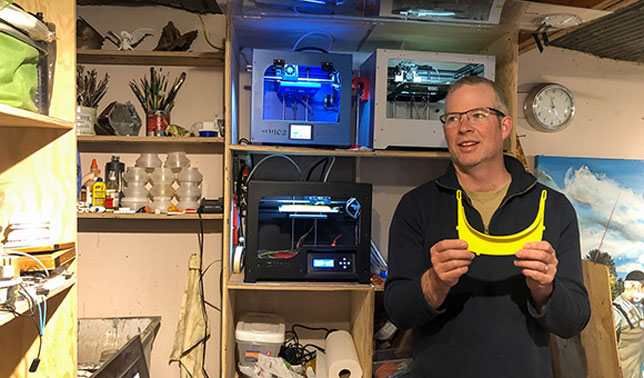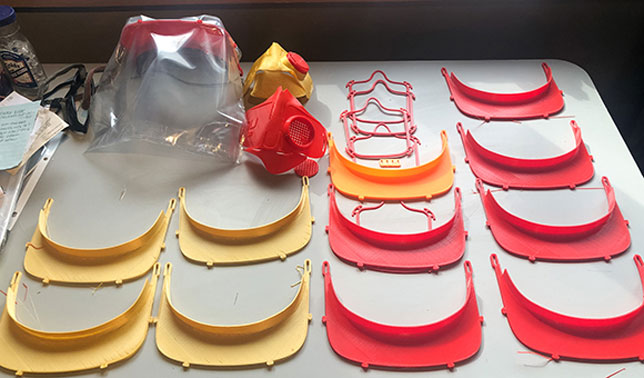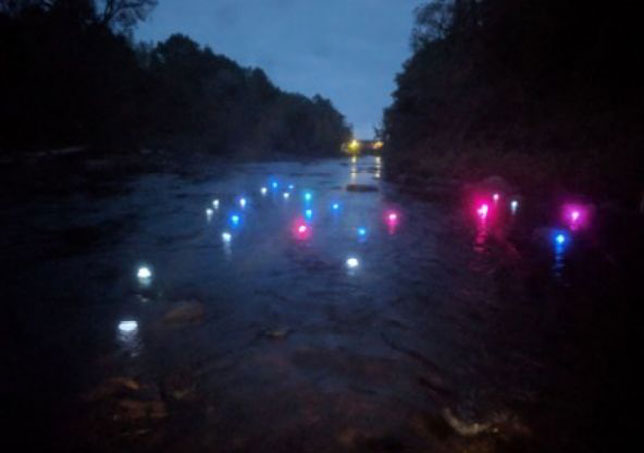Free Online Course to Help Fast-Track 3D Printing Skills
- By Dian Schaffhauser
- 04/07/20

SUNY Canton Professor Matthew Burnett holds a piece of a face shield he printed in his own studio.
State University of New York (SUNY) Canton Professor Matthew Burnett has been making face shield components to help medical staff protect themselves against COVID-19 as they deal with a deluge of patients in that state. Like many 3D printing enthusiasts, Burnett heard about the need for personal protective equipment at area hospitals and immediately set up printers to produce components.
"As hospitals in New York State are facing shortages of essential equipment for this crisis, makers across the state have been connecting and asking how best they can help," Burnett said in a campus article about the work.
As a participant in the Northern NY 3D Printing Network, Burnett and his fellow 3D afficionados are fulfilling requests from at least 10 different medical affiliates in northern New York, which need some 1,500 units. The graphic and multimedia design instructor said he has single-handedly made more than 150 visors since March 21.

Some of the 3D-printed components for medical face shields made by SUNY Canton Graphic and Multimedia Design Professor Matthew Burnett.
To build capacity and expertise out in the wider world, Burnett, who has been teaching in online and hybrid formats for 13 years, has begun offering free weekly instruction via Zoom for those who are interested in 3D modeling and printing. While the first class drew about a dozen people, interest has been increasing, he said.
Having an actual 3D printer is optional at this point. "The first few lessons will focus on modeling only. Later lessons will discuss the printing portions of the process," Burnett noted. While the lessons cover "complete skills in [and] of themselves," the cumulative outcome is intended to help learners develop CAD knowledge for 3D printing. The base skills can also be used for graphic design, project modeling, building information modeling for architecture and interior design.
While the lessons don't specifically cover how to 3D print gear for healthcare workers, they're intended to teach "hands-on skills remotely for our 21st-century needs," Burnett said. "Now seemed a prime time to fast-track general CAD skills for friends and family. [With] so many people stuck on their premises, it is a good time to focus on skills with free resources that are available to all."
Burnett has a special interest in combining international faculty and students to tackle cooperative projects. In 2018, he worked with Associate Professor Bridget Benson, a member of the Electrical & Computer Engineering faculty at California Polytechnical State University, on a joint engineering and arts education project. "Convergence," as it was called, involved an international effort to design and 3D-print a hundred smart-LED lighted miniature vessels that floated down a river with two different colors, eventually mixing together and changing to the same color further downstream when they reached designated coordinates.

3D-printed LED-lighted vessels floating down the Grasse River in northern New York. When they reached a particular location, they automatically changed color to green. Source: Matt Burnett and Andrew Randall
"Even though we have been socially distanced by this crisis, we have technology that makes it possible for us to stay productive and connected," Burnett observed. "It is a good time for individual study, and I am thinking of lots of people who can benefit: children who have been cut off from their school and are hungry for stimulation; beginners who have been curious about 3D printing and design and never had the time; and, of course, I relish any chance to improve my communication and online teaching pedagogy."
The course runs weekly from 1:00 to 3:00 p.m. Eastern time on Wednesdays through Zoom. To learn more, e-mail Burnett directly at [email protected].
About the Author
Dian Schaffhauser is a former senior contributing editor for 1105 Media's education publications THE Journal, Campus Technology and Spaces4Learning.